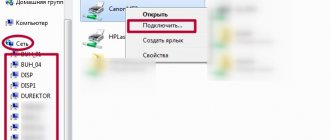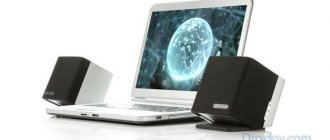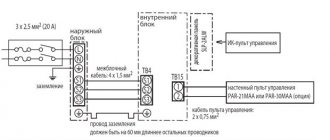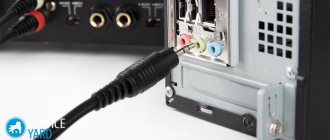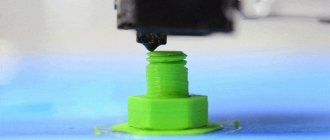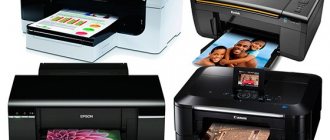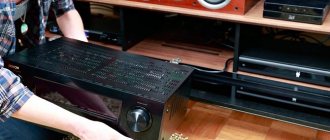How to connect?
There are two ways:
- network;
- local.
Usually, a connection via a cable is enough to work; then the device itself recognizes the printer. All that remains is to install the software, or download the driver or program, which is usually included on the disk included with the printer itself. After installing the necessary applications, you can print.
However, this is not always the case, especially in Windows 7. The owner will have to configure the equipment himself and force his PC to recognize the connected device. Drivers are usually included with the printer.
Connect the printer to the computer using a USB cable
The next step in connecting the printer to a computer or laptop is connecting the computer and printer using a USB cable. Most often, a USB cable comes with the printer. But, if there is no cable or it is lost, then you can buy it at the nearest computer hardware store.
To connect the printer to our computer you will need a regular USB cable. Please note that on one side the USB cable has an elongated connector - it is called Type A connector, and on the other there is an almost square connector - it is called Type B. We connect the Type A connector to the computer, and Type B to the printer.
If the printer is connected using a USB 3.0 cable, the Type B connector (which connects to the printer) will be slightly different. It is blue in color and slightly larger in size.
Via network cable
Connecting a device via a network cable involves several steps.
Stage 1
- One end of the wire is connected to the printer, and the other to the system unit.
We connect one end of the wire to the printer, and the other to the system unit - Click the Printscreen button. The device will “spit out” the sheet with the IP address.
Press the “Printscreen” button on the printer - On the PC, press the start button, the printing devices section, as in the picture.
Expand the “Start” menu, open the “Devices and Printers” section - Click the “Add Printer” button located at the top.
Click the “Add a printer” button at the top - The installation wizard will ask you what type of device you are connecting to. Select the first item in the window. That is, a local device, with a note that its use is permissible only in the absence of a USB printer.
Click on “Add a local printer” and click “Next”
Stage 2
- A window will appear where the system will ask you to select the port for the connected device. In the field, click create new.
Oh, click “Next”On a note! In the English version, “Use the following” means select the proposed one, the second means “Create a new port” - set up a new one.
- From all the available options, after clicking the corresponding line, select “Standard TCP/IP Port”. Confirm with the “Next” or “Next” button if the selected language is English.
Select “Standard TCP/IP Port”, click “Next” - The system will prompt you to select an IP address. The piece of paper with IP printed out at the very beginning will come in handy here. The numbers from it are entered into the form. All that remains is to confirm the action by clicking on the “OK” button.
In the “Port name” field, enter the printer’s IP from the printed sheet, click “OK”
Stage 3
Now the lack of a driver separates the user from using the device as intended. To search, click the “Browse” button, update center. Windows itself will download what you need.
Select your printer in the list, click “Windows Update”
Attention! The Internet must be available for this!
Stage 4
All that remains is to designate who will have access to the device:
- open the device properties by right-clicking on the printer name icon;
Right-click on the printer icon, then left-click on the line “Printer properties” - and in the “Access” tab, mark the item for sharing the printer.
In the “Access” tab, check the box for sharing the printer
Connection in Mac OS X
This instruction is for those who prefer Apple products. In this case, the algorithm will be slightly different.
- The first thing a computer owner needs to do is check that all necessary updates are installed on the PC. That is, drivers and patches of the latest version.
- Find a convenient location for the printer and make sure there is no tension on the wire.
- Connect the printer to a power source and turn on the device. Turn on your PC and wait until the system boots completely.
- Connect your PC and printer using a cable. If the computer is not equipped with standard connectors, then you will have to buy an adapter, clarify this point and take care of the availability of additional elements in advance.
- As soon as the computer recognizes the device, a dialog box will appear. Click the "Install" command.
- Wait for the process to complete. In some cases, you will have to confirm several times in a pop-up window.
Now the setup is complete, you can start printing.
How to connect a printer to a computer: a guide for all cases
Today we will look at one of the pressing issues for novice computer users. Although, many experienced PC owners will find the information useful. Let's look at detailed instructions on how to connect the printer to a computer via a cord and using WiFi. These recommendations will be useful not only for users of the Windows operating system; there will also be a separate guide for Mac OS X owners.
Connection via cable
First, let's figure out how to make connections in the standard, familiar way. The cord for connecting the PC and the printer is included with the latter. Therefore, there is no need to purchase additional elements.
Instructions for Windows
It would seem that the process is purely technical in nature, and there should be no difference between the operating systems. However, in addition to purely mechanical actions, small system settings are required that will differ. Therefore, the connection algorithms will be slightly different.
- First you need to decide on the location of the devices. It is necessary to prepare a place for the printer so that it is located not far from the computer. The main criterion in this matter is that the cord should be positioned freely between the devices, without unnecessary tension.
- Connect the printer to a power source and turn it on. The power button is located on the front panel of the printer and has a standard marking.
- Turn on your computer and wait for it to fully boot into working condition.
- Take a USB cable and connect the printer and computer.
- If your printer model provides this option, then the system setup may occur automatically. That is, the PC will independently recognize the external device, install the necessary drivers, and after a couple of minutes the printer will be ready for use. This is the most ideal option. But there are situations when manual configuration becomes necessary. Open the Start menu.
- In the right menu block, select the “Devices and Printers” section. You can also find it by entering the corresponding phrase in the search.
- Then select the “Add Device” command, it is usually located in the upper left part of the system dialog box.
- The search for devices will start. Wait until it's finished and click on your printer name.
- Click Next and follow the onscreen instructions. If additional configuration and driver installation is required, when prompted, insert the media supplied with the printer into the drive. Alternatively, drivers can be installed via the Internet from the manufacturer’s website.
After this, your printer will be ready for use and you can send documents for printing.
Connection in Mac OS X
This instruction is for those who prefer Apple products. In this case, the algorithm will be slightly different.
- The first thing a computer owner needs to do is check that all necessary updates are installed on the PC. That is, drivers and patches of the latest version.
- Find a convenient location for the printer and make sure there is no tension on the wire.
- Connect the printer to a power source and turn on the device. Turn on your PC and wait until the system boots completely.
- Connect your PC and printer using a cable. If the computer is not equipped with standard connectors, then you will have to buy an adapter, clarify this point and take care of the availability of additional elements in advance.
- As soon as the computer recognizes the device, a dialog box will appear. Click the "Install" command.
- Wait for the process to complete. In some cases, you will have to confirm several times in a pop-up window.
Now the setup is complete, you can start printing.
How to connect a printer to a computer via WiFi
Another convenient option for connecting a printer is WiFi. Today there are routers in almost every home, so we will consider the instructions for connecting via a wireless network as a separate block. In order for the operation to be successful, prepare instructions from the printing device. In it you need to read which module the printer uses to connect: WiFi or Bluetooth.
Connecting to Windows OS
In order to solve the question of how to connect a printer to a computer, just follow the following algorithm.
- Turn on the printer and, if necessary, connect the printer to the router via a special Internet cable. This is often required for initial setup. But some printers immediately support wireless connections.
- In the instructions or on the manufacturer's website, check how a specific model connects to the network. Some need to be connected to the PC first (instructions above). If the printer can connect to the wireless network on its own, use the on-screen menu to locate the access point and enter the password.
- If the printer supports a WiFi module, then just find the network to which the PC is connected and enter the security code. To connect via Bluetooth, just find and press the pairing button.
- Then on your PC, open the “Start” menu and go to the “Printers and Devices” section and follow the procedure described above to add a device if it is not already shown in the list of available ones. If the connection is made via Bluetooth, then to detect the printer you need to enable this module on the PC.
- Click the "Add" or "Connect" command next to your printer name.
After this, you can use the printing device. It is important that the printer is located closer to the router so that there are no interruptions in the signal.
Recommendations for Mac OS X
Now let's figure out how to connect a printer to a computer via a wireless network in Mac OS X. The essence is almost the same as in the previous case. First you need to find out which module the printer is equipped with and whether a PC or Internet cable is required for connection.
- Install the printer where the signal from the router is best.
- Turn on the output device and computer, wait until it boots completely.
- Follow the instructions in your specific model's user manual to connect to your network. Using the printer menu, find the network you want and enter the security key. You need to select the same access point as the PC. If using Bluetooth, press the pairing button.
- Then on your PC, open the menu (apple icon in the top left corner) and go to system settings.
- Open the "Printers and Scanners" section. Click on “+” and by clicking on the name of your printer, add the device following the system prompts. Often the printer automatically appears in the list of available devices, in which case no action is required from the user.
That's all, the connection is complete, the printer is available for printing.
By following the instructions provided, the question of how to connect the printer to your computer will no longer arise. If you encounter difficulties, write in the comments, we will try to help you. Share the article with your friends and stay with us. We will tell you a lot of useful and interesting things.
Wi-Fi and Bluetooth connectivity
There are models of MFPs, inkjet printers and laser printers that support connection using wireless technologies. For example, you can take the Canon PIXMA G3400 inkjet, which has the ability to connect via Wi-Fi. A small nuance should be taken into account: this device connects to a Wi-Fi router using WPS technology. Therefore, you need to buy a router that supports WPS, and this feature must be enabled on it. The following figure shows how to enable WPS on the D-Link DIR-615 router.
Next, to connect your Canon PIXMA G3400 to a wireless network on Windows 10, you will need to follow these steps.
- Turn on the device to the network and press the button marked “Wi-Fi” located on it. Keep it pressed until the orange LED flashes once. After this, the blue Wi-Fi indicator will start blinking, indicating that the device has started searching for a wireless network.
- At this stage, you will need to connect the router to your inkjet machine (laser machine). Press the WPS button on it and hold it until the blue indicator on the inkjet stops blinking and begins to glow steadily. This will indicate that the printer has connected to the Wi-Fi network.
- Next, it is necessary for the OS to see the equipment. To do this, through the “Start” menu, select the “Settings” tab, after which a new window will open.
- Select the “Devices” section and click on “Add a printer or scanner”. The system will begin searching for equipment and ultimately display a link “The printer you need is not in the list,” which you will need to click.
- Next, you should place a marker near the item, as shown in the following figure.
- By clicking the “Next” button, a search for equipment (Bluetooth or Wi-Fi printer) will start. Select the required found equipment and click “Next”.
- After this, the necessary drivers will be installed and the equipment will be ready for use.
Connection and configuration methods
The next step is to connect the copier to your computer or laptop. This is done in several ways:
- using a USB cable;
- via Wi-Fi (if available).
In both cases, it is recommended to install the copier drivers that come with it. If they were lost, then you can download them for the applicable model from the Internet from the appropriate resource.
Via USB
To connect via a USB cable and set up a copier from Brother, Benq or another model, do this:
- install copier drivers (from disk or pre-downloaded from the Internet) onto your computer using the Software Installation Wizard, following its instructions;
- connect the PC to the networked copier via a USB cable, using the appropriate connectors, as shown in the photographs below;
- The computer will automatically find new hardware.
After this, you can make a test copy and work with the device.
Using Wi-Fi
Step-by-step instructions for connecting via Wi-Fi boil down to the following steps:
- include a copier;
- select the Wi-Fi icon on its display;
- do automatic network search;
- Among the found connection points, select the one you are using and enter the password for it;
- install drivers in the standard way (default) of the device used on the computer, noting the connection method via Wi-Fi;
- after detecting the PC of the copier, select it and click “Next”;
- When the installation is completed, then the copier is ready for use.
If there is a signal light, then it will light up when the setup is complete.
If you need to organize access to the copier from several PCs, you should connect to the device through the “Printers and Faxes” tab. In this case, it must be designated as the default network equipment.
Using a print server
A print server is a small device that connects to a local network and a printer, and then allows all devices on the network to access that printer.
It is worth keeping in mind that the word “print server” has very many meanings. Some equipment (for example, routers or switches) have a print server function - that is, they have a special interface and web configurator for connecting the printer to a local network. A print server is also called software that allows the computer itself to become such a server. In general, to avoid confusion, below we will call “print server” only the individual devices themselves that perform only this function.
The cost of print servers ranges from 2 to 5 thousand rubles
The main problem with print servers is compatibility. Typically, these boxes are produced by the manufacturers of printing devices themselves - for example, print servers from Canon, Epson, and HP LaserJet are very popular. However, they are usually only able to work with their own printers. Therefore, before purchasing, be sure to find out what devices the print server you are targeting supports. This information is always available on the box manufacturer's website.
How to use a print server? It’s very simple - you need to connect a printer to a USB port, and connect the print server itself to a local network router using a patch cord. Details of connecting to the network may vary from manufacturer to manufacturer, so here we will direct you to the operating instructions - they always cover this point in detail. Most print servers also come with disks for quick installation. The print server is usually configured, like routers, through the web interface.
After this, all computers connected to the same local network will have access to the printer. There is no need to install drivers or configure access - that’s the beauty of special equipment.
Via router
The printing device can be connected to a local network and via a router if it has a USB port. In this case, you need to turn off the printer and router, connect them with a USB cable, and then turn them on again.
If the printer can connect to Wi-Fi, then you can do without wires. In the printer menu, find the desired network, enter the password for it and connect. Detailed instructions on how to connect to Wi-Fi specifically on your model will be in the user manual for the device.
This connection has a number of disadvantages. Firstly, the performance of the printer strongly depends on the router firmware - it must be updated regularly, and if after the update the printer stops working, it must be rolled back. Secondly, drivers for the printer will have to be installed on each PC that is connected to the network. Thirdly, in Russian apartments the router is often located in the hallway. Putting a much bulkier printer there is not the best idea. Therefore, for home use, it is better to abandon the router in favor of a regular cable connection to the computer.
Settings
All devices connected to the router's network will be able to access it after a short setup process:
- Click Start - Control Panel (Windows 7) or right-click Start - Control Panel (Windows 8, 8.1 and 10).
- Select "Devices and Printers".
If you have difficulty finding the item you need, enter it in the search box
- Now click on “Add a Printer”.
The required button is located at the top of the window
- The search for the printer will begin, but we are not interested in it. Immediately click “The printer you require is not in the list.”
Searching for a printer will not give us the desired result, so we can skip it
- In the window that opens, select the third item - search by TCP/IP. Further.
If you connected the printer to the router, then this is the only way we can recognize it
- Select Device Type - TCP/IP. Enter 192.168.1.1 twice. If you use a different address to access your router's web interface, enter it. Do not check the “Poll the printer” checkbox. Click Next.
Here you need to enter in the fields a combination of numbers that opens access to the router’s web configurator - usually this is 192.168.1.1
- Now check the “Special” checkbox and then click on “Options” next to it.
Here we can set some parameters manually
- Check the LPR checkbox and enter any name in Latin in the “Queue name” field. For simplicity, you can enter the brand of your PC. Click OK.
Do not change anything else in this window - this may cause the printer to not work.
- You will be returned to the previous window. Without changing the checkbox, click Next.
- Windows will now ask you to install drivers. If you have a disk with them, install the software from the disk - it will be easiest. If not, then download the drivers from the official website of the printer manufacturer.
- After installing the driver, the system will ask you to name the printer. You can call it whatever you want.
- Steps 1 - 11 must be performed on each computer that will use the network printer.
How to connect a printer scanner to a computer
Until this point, connecting a printer or scanner to a computer was quite a difficult task.
It was necessary to find a special port, make sure that all system drivers are correctly configured, and hope that everything is installed correctly and your OS (Operating System) will give you the opportunity to scan or print the treasured document. Thanks to these instructions, everything has become much easier. If your goal is to print documents, connect a printer or scanner to a computer, you need to set up remote access (print documents using the Internet), and you are asking the question “How to connect a printer or scanner to a computer” - these instructions are for you!
Connecting a Printer to a Personal Computer
Stage No. 1. Placing the printer next to the PC (Personal Computer).
Make sure the printer or scanner is within easy reach of the cable or port. In other words, the cable should not be tense, it should lie freely. Tip : Carefully roll up the excess cable and tie it with a rope, this will help you avoid tripping over the cable and increase its durability.
Stage No. 2 . Software.
To facilitate the process of connecting the device to a PC, install the necessary software (software, drivers) supplied with the printer/scanner.
Tip : If you don’t have a disk with the software, don’t worry, the Windows system itself is capable of automatically detecting the printer and scanner that is connected to the PC. Also, if all this does not happen, you can go to the printer manufacturer’s website and download the driver you need yourself; as a rule, it is located in the “Software and Drivers” section (Almost all modern sites are able to detect your printer scanner automatically).
Stage No. 3 . Connecting a printer scanner.
One of the next steps in solving the question “How to connect a printer scanner to a computer” is a direct connection to the USB connector.
Advice : at this stage, make sure that your printer and scanner is connected to a power outlet and to the computer.
Stage No. 4 . Follow your operating system's instructions.
At this stage of connecting the printer scanner to the PC, your operating system will do all the work for you, just click next. At this stage, the complete and final installation of drivers occurs.
Advice : if the system before or after this stage still does not see your printer scanner: try connecting your cable to another USB connector, or completely uninstall the drivers and return to stage No. 2.
Stage No. 5 . Check whether your printer or scanner was installed correctly and correctly.
- Open the Start menu, click on “Control Panel”.
- Next, “Devices and Printers (View Devices and Printers).”
- Find the desired printer in the list of connected devices.
Ready! After these manipulations, your printer and scanner is connected and fully operational.
How to connect a network printer scanner to a computer?
In order to install a printer that will be accessible to all PCs on your network, you should:
Stage No. 1 . Check the network connectivity of your printer/scanner.
First, you should determine whether the printer scanner has a special connector, such as “Ethernet”.
If the printer/scanner does not have this connector, you should connect it to the so-called “Print Server” (a small device required to connect to the network) using a USB cable.
Stage No. 2 . Place the computer within the range of the wireless network signal.
Your device must be able to send and receive signals from your modem or wireless router.
Tip : When connecting a printer scanner via the Ethernet port, you should connect a router to it. In other words, the closer the printer/scanner is to the router, the better for print quality and speed.
Stage No. 3 . Turn on your device, then follow the simple instructions on the screen, they will help you connect to the network.
Tip : A prerequisite for connecting some devices is to connect to a PC directly, and some models are equipped with the function of setting up a connection to a wireless network on their display. If your device supports a wireless network, click “network” in the menu. Next, you will need to enter a password, it will give you access to the wireless network.
Stage No. 4 . Connecting a PC to a network printer or scanner.
At this stage, you will have to install and configure the device on your operating system. For this:
- Open the Start menu, go to Control Panel and click on “Devices and Printers/View Devices and Printers”.
- Click on "Add Printer".
- Click on "Add a network, wireless or Bluetooth printer."
- Your operating system will find nearby devices connected to the network.
- Select the device you need from the list and simply follow the further instructions.
If your goal is “providing shared access to your printer or scanner,” you should do a couple of simple manipulations
Stage No. 1 . You should connect the device using “Connecting a printer to a PC”
Stage No. 2 . Open the Control Panel menu and click "Network and Sharing Center (Network and Internet)"
Stage No. 3 . Click "Change advanced sharing settings"
Stage No. 4 . Select the Home or Work/Guest or Public slide-out menu
Stage No. 5 . Click on “Enable file and printer sharing” and save your changes.
Also worth reading
Installing drivers
If the Windows system does not automatically install the drivers, then you need to do it manually yourself. The printer will not print without special software. An excellent scenario for you is to have an installation disk. If the device is not new or comes without a disk, then the situation is more complicated.
Using the installation disk
In the box with the equipment there should be a disk with drivers, or maybe several for different operating systems and types of systems. The installation process is very simple:
- Find the correct type of disk. Must correspond to the OS version and its bit depth.
- Insert it into the drive and wait for the installation wizard to autostart.
- Follow the program's instructions.
- Choose customizable settings to suit your needs.
If there is no disk
There is also a way out of this situation, and even several.
- You can download the driver on the website of the manufacturer of your device model. Cybersecurity experts recommend downloading any software from the original source sites. All you need to know is the exact model name. It is indicated on the product itself or its box. After downloading, run the exe or msi installation file and follow the instructions of the installation wizard.
- You can also use the built-in driver database in the Windows system itself. This database is available in any version. Through the control panel, go to the devices and printers section. Click on the button to install a new device.
In the first window, select installing a local printer.
At the next step you will be able to select drivers for your model.
Follow the prompts and click “Next” everywhere. After the installation is complete, we find this new device in the list. Using the context menu, remove the newly installed printer.
We turn on the device, wait a bit and try to print. - Enable automatic detection and installation of software for any connected device. In the “Devices and Printers” section, you need to find your PC in the list. In the context menu, select “Installation options”. In the window that opens, agree to automatic downloading.
We reboot our computer, wait for the system to try to download drivers from the Internet on its own.
Installing and setting up the printer
Not every printer will start working immediately after connecting to a computer. Some models require the installation of appropriate drivers and software to manage the device. As a rule, all necessary utilities should be included on a separate disk. But even if you have lost such a disk, you can always download the necessary drivers from the manufacturer’s website. By the way, it won’t hurt to do this even if you have a disk, since the site may contain newer drivers with corrected errors found. Next, we'll take a closer look at how to connect a printer to a computer.
Connecting the printer to your computer
Connect the printer to your computer using a cable, and only then plug the power cord into a power outlet. Today, most printers are connected to a computer via a USB port. If you have a network printer, you can connect it via a wireless WiFi network or a standard RJ-45 network cable. You can read more about connecting various cables in the article “How to connect a cable to a computer.”
Setting up the printer and installing software
For ease of use of most printers, manufacturers provide special software that will also help install the printer in your operating system. 1. After connecting and connecting all the necessary cables, you should turn on the computer. 2. Insert the CD that came with your printer into your computer's CD drive. If the disc does not start automatically, open File Explorer, double-click the CD drive, locate and run the installation file. If you downloaded drivers from the manufacturer's website, run the downloaded file. 3. Follow the instructions of the installation wizard, after which the software will be installed on your computer. 4. Run a test print on the printer to make sure it is working properly.
Installing a printer with only drivers available
If you want to install only drivers without installing additional software when installing the printer, follow the instructions below. But if you have already installed the printer using the method described above, there is no point in taking further steps, unless, of course, errors appeared during installation. 1. After connecting the printer, go to the “Control Panel”
.
2. In the control panel, double-click on the item “View devices and printers”
.
3. Launch the Add Printer Wizard by selecting “Add a Printer”
.
4. The message “Select the type of printer to install”
.
If the printer is connected to your computer, select Add a local printer
. 5. When prompted for the location of the drivers, select the folder with the drivers on your computer or specify their location on the CD.
Printer testing
In Windows, after installing the printer, you can test it by printing a test page. 1. Go to “Control Panel”
.
2. Double-click the View devices and printers
.
3. Select the required printer and go to “Printer Properties”
.
If you do not see your printer, it means it is not installed. 4. On the General
, click
the Test Print
. 5. If the printer prints a test page, it means it is installed and configured correctly.
Also interesting articles on the site:
Using backups to protect information Inexpensive Asus R512MA laptop Iscom switches from raisecom How to set a password on a router
Printing from a smartphone
Modern phones have a built-in operating system. It can be IOS or Android. Setting up printing from a smartphone or tablet involves connecting a printer in one of these mobile operating systems. As is the case with Windows, there are two connection methods:
- A direct connection via cable will require the use of a special adapter.
- Network access requires the installation of special applications. This could be AirPrint for Apple equipment, Google Cloud Print for Android systems, software from printer manufacturers - ePrint from HP.
All methods of connecting a phone or tablet to a printer and setting up printing via Wi-Hi. A detailed description of the options for all possible options to 'make friends' with Android or IOS equipment with your printing equipment.
Setting up an ink jet (laser) for printing
To configure the device, you need to go to “Devices and Printers”, right-click on the desired equipment and select “Printer Properties”. To check the functionality of the machine, click on “Test Print”.
By clicking the “Print Settings” button, you can select the paper size and determine the page orientation, as well as the print quality.
How to turn on the default printer
Sometimes it happens that several printing devices are connected to the computer. But if you use one of them most often, then constantly choosing it from the list is very inconvenient. The problem is solved in a fairly simple way: you need to add the desired inkjet (laser) to the default devices:
- open control panel:
- open the “Printers and Faxes” section;
- Double-click on the required equipment and check the box next to the “Use as default” line.
For convenience, make a shortcut to the “Printers and Faxes” folder and place it on your desktop or pin it to the Start screen in Windows 10.
Setting up a print queue
Print queue management allows the user to control all documents in its list . Thanks to this service, you can re-select and send a document for printing at any time. You can also put it in “Favorites” so that you don’t have to send it for printing next time.
There are 3 types of print queues:
- general - all PC users can perform any tasks;
- direct - you can print out a document from the designated equipment;
- secure—printing the document will not be possible without authorization.
In the event of a failure, the inkjet printer (laser printer) may refuse to print documents from the queue, or will print the same document without moving on to the next one. In this case, the queue can be cleared by double-clicking on the icon of the desired device in the control panel. Next, click on the “Printer” menu and select the “Clear print queue” line.
Setting up color printing
Setting the color profile is a very important step for high-quality color reproduction when printing. You might have seen, for example, in the device settings for printing, the choice of either glossy paper or matte paper. Each type of photo paper has its own color profile in the form of a special file containing specific commands for the inkjet printer.
Color profiles for the ink or paper used can be downloaded from the Internet and installed on your computer.
You can also set up color printing manually, by trial and error, creating your own profile for the highest quality color reproduction. To do this, use the inkjet driver. For example, setting up a Canon inkjet driver will look like this.
- First, open the printer driver window. Click in turn: “Control Panel” and “Devices and Printers”. After that, right-click on the desired equipment and select “Printer Properties”.
- Select the Main tab and select Manual color settings, then click on “Set...”.
- In the manual color settings window that opens, check the box next to “Print a pattern for color adjustment” and click on the “Pattern Print...” button to set the printing parameters.
- After opening the next window, select the options as in the image below. By the way, the paper size may be different, for example, A4. After making changes, click OK.
- Make a test print by clicking OK on the (Main) tab. A sheet will be printed with several images in which the color balance will vary.
- Having looked at the result, you should select the image with the best (natural) color rendition and remember the values that are written under it.
- In the color settings window, enter the color balance values that were indicated under the picture opposite Cyan, Magenta and Yellow.
- Uncheck the box next to “Print a pattern for color...” and print the image you need.
Now printing will be done taking into account color balance adjustments, and images will look better and more realistic. Print driver windows from different manufacturers may differ in the set of commands and button layout. But in general, the algorithm for adjusting the color balance is similar, and its implementation will not cause any particular difficulties.
Possible connection problems
Many people have encountered errors when trying to connect a printer to a computer. To properly switch devices, it is necessary to urgently solve the problem that has arisen, and therefore find the cause.
If you do not see your device in this tab or it is not working correctly, you need to look for the cause of the failure
If the computer does not see the printer: what could it be?
Have you bought a new printer, but when you try to install the device to work via a computer, it is not visible in the devices? Most likely, the problem is in the installation disk, or more precisely, that the drivers on it are outdated. In this situation, you can download a more recent version of the utilities.
If antivirus is enabled on your OS, the program can also block the connection being created. Therefore, temporarily disable the application and restart your PC. If this action does not help, check your PC for viruses, and, of course, check that all cables and settings are connected correctly (if it is wireless switching).
We complete connecting the printer to the computer by installing drivers
After the printer is connected to power and connected to the computer using a USB cable, you can begin installing drivers. Drivers are usually supplied on disk with the printer. If the printer comes with several disks at once, then study the labels on them. We need the disk that says “Driver” on it.
Insert the driver disc into your computer. After this, the printer driver installer will start. The process of installing drivers is very simple and is not much different from installing a regular program. You may have to disconnect and reconnect your printer during the installation process. If such a need arises, the installer will notify you about it.
After the installation process is complete, you may need to restart your computer. If such a need arises, the installer will inform you about this.
If you do not have a driver disk or installation from the disk does not start, then you can find the driver on the Internet. It is best to download the driver from the official website of the printer manufacturer. In this case, you can get the latest version of the driver without the risk of contracting a virus.
